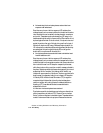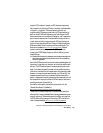Section 4: Safety Guidelines and Warranty Information
118 4A: Safety
base stations are typically thousands of times lower than those they can
get from wireless phones. Base stations are thus not the primary subject
of the safety questions discussed in this document.
18. What kinds of phones are the subject of this update?
The term “wireless phone” refers here to hand-held wireless phones with
built-in antennas, often called “cell,” “mobile,” or “PCS” phones. These
types of wireless phones can expose the user to measurable radio
frequency energy (RF) because of the short distance between the phone
and the user’s head. These RF exposures are limited by Federal
Communications Commission safety guidelines that were developed with
the advice of FDA and other federal health and safety agencies. When the
phone is located at greater distances from the user, the exposure to RF is
drastically lower because a person's RF exposure decreases rapidly with
increasing distance from the source. The so-called "cordless phones,"
which have a base unit connected to the telephone wiring in a house,
typically operate at far lower power levels, and thus produce RF exposures
well within the FCC's compliance limits.
19. What are the results of the research done already?
The research done thus far has produced conflicting results, and many
studies have suffered from flaws in their research methods. Animal
experiments investigating the effects of radio frequency energy (RF)
exposures characteristic of wireless phones have yielded conflicting
results that often cannot be repeated in other laboratories. A few animal
studies, however, have suggested that low levels of RF could accelerate the
development of cancer in laboratory animals. However, many of the
studies that showed increased tumor development used animals that had
been genetically engineered or treated with cancer-causing chemicals so
as to be pre-disposed to develop cancer in the absence of RF exposure.
Other studies exposed the animals to RF for up to 22 hours per day. These
conditions are not similar to the conditions under which people use
wireless phones, so we don’t know with certainty what the results of such
studies mean for human health.
Three large epidemiology studies have been published since December
2000. Between them, the studies investigated any possible association
between the use of wireless phones and primary brain cancer, glioma,


















